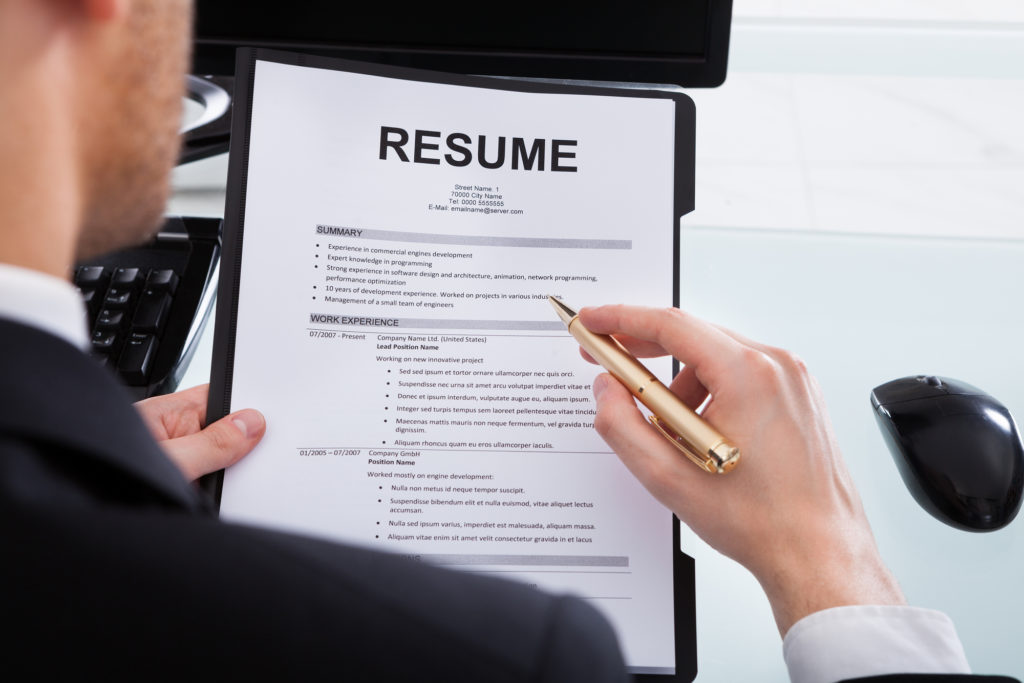How to Write a Professional Resume which gets you Shortlisted for the Interview

During an interview, you may get thirty minutes to one hour to correct a wrong answer to improve your impression. Still, your resume only gets a few seconds to a couple of minutes for the employer to decide if you are the right candidate or not.
Your resume gives you only one chance and not a second at one company. You are either in or out to reach the interview stage. How do you improve that chance? While you read through this, you can also get a free resume review to get advice and help with writing your CV.
It’s like a novel that may have a great story, but the way it is written decides whether it will become a bestseller. Here are some tips to make a resume more effective.
The resume should not list down your skills and experiences but need to make a statement about you.
Let’s look at some of the main points and some resume-writing tips to help you create a better resume.
The resumes should focus on the following:
- Clarity of thoughts and preciseness
- Readability and a professional structure
- Your authority on what is expected – Customization according to the job description
- Not just aptitude but, very importantly soft skills and a positive attitude
Please note that some of the above can be indicated by quoting examples, etc., instead of wording in black & white.
Clarity of thoughts and preciseness
If you cannot show your strengths in just 3 to 4 pages, you cannot do that in 10 pages. No one has the time to read an 8- or 10-page resume, but such a long resume creates the first impression that you do not have the required strengths, and hence you are talking more, and you are not a person of action the words. Keep your resume size to 3 to 4 pages or a maximum of 5 pages.
Please read the job description clearly, note the main keywords, and highlight your capabilities and skills using the same terminology or keywords.
Readability and a professional resume structure
Resume Font-Size
Use commonly used clear fonts, e.g., Ariel, Times New Roman, or Calibri. Do not use fancy fonts, which may be difficult to read. Do not use very small or very large font sizes. Keep the font size 11 to 12 because the person reading the resume may not have ideal eye sight.
Resume Structure
There is no ideal structure for a resume, but we can get some tips from the LinkedIn profile structure, which has become the world’s largest professional community and employment-oriented service. A good resume structure can have the following:
- Summary
- Experience (job history)
- Education
- Licenses and Certifications
- Skill-set
- Accomplishments and/or Awards and Recognitions
The only change in the order you may like to make is having the skill-set just after the summary section.
Summary Section
The summary at the top of the resume is the heart of the resume. Put a summary section at the very top of the resume. It should clearly highlight your experience, skill sets, aptitude, and attitude in a very crisp manner in 6 to 10 sentences. Please note that most resumes could be dropped just after the hiring manager reads the summary.
If you are not a fresher, it is better not to have the “Objective” section. You can write about the objective in the summary section. While the summary shows your fitness for the job, use a couple of sentences inside the summary as an objective to make an impression about your attitude and aptitude.
In countries like Japan, where bilingual skills in Japanese and English is highly desirable for many jobs, it is important to include that in summary, even if you are mentioning that under Licenses & Certifications and Skills.
Use Power-words. Some of the power words could be Accomplished, Directed, Designed, Initiated, Persuaded, Set goals, Achieved, Improved, Supervised, Oversaw, Forecasted, Coordinated, Passion, Leadership, and Responsibility.
A couple of very important points for the summary section, as well as elsewhere in the resume, are as follows:
- Pick up the relevant keywords from the job description and include those in the summary wherever applicable.
- Check the company’s website and try to see its business focus, core values, and vision. See if you can reflect on some of those things in your resume. This could be for your experience & skill set or for your personality.
- Include relevant buzzwords based on the latest industry trends. For example, everyone in IT currently talks about cloud, automation, and user experience. So, it’s better to add your inclination and/or experience/skills in these areas.
Both the Summary, Experiences, and Accomplishments sections need to show your authority on what is expected. Sometimes, it can be shown by just some certifications, etc., but most times, it can be shown by the way you use the words and write your resume.
The following can show that you are an authority on the subject:
- Self-rating of your skills
- Examples of experiences/projects that are same/similar to the role you are applying for
- Mention your accomplishments precisely for the above point
- Quantifying your accomplishments (using percentages and numbers) as mentioned in the next section.
- Use of power-words as mentioned above
Experience (job history)
- Mention your roles and responsibilities and what skill sets you used to carry out your duties.
- Use bullet points wherever possible, and avoid writing lengthy descriptions. No one would be reading long essays.
- Mention the achievements and not just tasks.
- Wherever you can quantify your accomplishments, do quantify. Numbers and percentages always impress more. For example, automated the tasks to reduce 15 person-days efforts annually or achieved an average year-on-year sales growth of 20%
- Use power words, as mentioned in the summary section above
- Use the latest industry buzz-words, as mentioned in the summary section above
Education
List out all your higher educations and institutes which you attended for the same. No need to mention your grades, percentage of marks, etc., unless you were among the toppers.
Licenses and Certifications
List out all the certifications and licenses you had got, including the month/year when you got those. Japanese language proficiency certifications play an important role in Japan, so do not forget to mention those if you have cleared those tests.
However, for certifications like JPLT, do not just mention JLPT but mention the levels you have cleared. Not mentioning the levels would cast doubts about your personality, that you tend to hide things.
Skill-set
- Please check the job description carefully and mention all relevant skill sets. Do not miss out on mentioning a skill that you have and is desired in the JD.
- Do not mention completely unrelated skills because that will dilute your profile’s impression. For example, you may be a bilingual IT project Manager and might have done some translation work in the initial days of your career. If you mention “translation” in your skill set, it will have a negative impact and not a positive one.
- It may be a good idea to rate your skills on a scale of 1 to 10 or 1 to 5. Self-rating always shows confidence and creates trust.
Accomplishments and/or Awards and Recognitions
List out all accomplishments and awards & recognitions. Be it from your employers, clients, or some certifying authorities. Please note that some of the entries here may be the same as in the Licenses & Certification section. Please do not be shy in not listing them again here. List everything because it was your accomplishment.
Resume customization according to the job description
Your resume should show that you are tailor-made for the job. It does not mean that you should lie. Be honest, but customize the resume according to the requirements. This means that you should highlight the relevant skills and experiences, as requested in the job description. Pick up the keywords mentioned in the job description and try to use those.
You should precisely mention your skill set and experiences to reflect that you match the job description. However, customization only means customization, not fabrication, by mentioning the skills and experiences you do not have. Be honest with your resume.
Examples:
For an automation IT engineer, the JD might ask for Robotic Process Automation (RPA) experience and no particular tools like Automation Anywhere or UiPath, while your standard resume might mention a lot of experience with UiPath—in such cases, use the term RPA while mentioning the name of the tool.
Another example may be that the employer might be asking for an HR Compensation & Benefits (C&B) Manager – you might be an HR Generalist but with lots of experience in C&B – in such a case, highlight your C&B experience.
Not just aptitude but, very importantly, attitude
Any employer with clarity of thought would like to see the following traits in a potential employee:
- Enthusiasm
- Adaptability
- Are you a team player?
- Do you ask meaningful questions or question everything?
- Do you accept mistakes and learn from them?
- Are you excited about learning new things?
- Are you ambitious and passionate?
- How resilient are you?
- Leadership qualities – not just for the leadership roles but to see your growth potential
Use the summary, experience, and accomplishment sections to reflect some or all of the above. You can do it in both a direct and indirect manner:
Direct manner: In the summary section, you can always use some of these words as personal traits. For example, I am an enthusiastic team player who is flexible enough to adapt to different situations.
Indirect Manner: These personal traits can be shown indirectly in your experiences (job history) and accomplishments sections. You can show some of your achievements, which can reflect some of the above traits in how you handled some typical situations and scenarios.
Resume Formats
There are many free and paid templates and resume-building tools available. However, what is most important is content, clarity of thought, authority on the subject, preciseness, skill-match, readability, and all the points mentioned above.
An attractive resume format may catch attention, but in the end, it is all about the content.

One important tip here – if you are sending your resume directly to a potential employer, then you should send a pdf format. However, if you are sending it to a recruitment agency, then send a Word document (for Japanese resume, the Excel file). The reason is that the recruitment company may need to put your resume in their standard format and also will need to put their company’s logo, etc.
We hope that these simple but effective tips will help you make a stronger and professional resume.
While a professional resume is a must to better your chances of shortlisting for a job, a professionally maintained LinkedIn profile is essential for professional branding. Here are some LinkedIn profile tips.

Educated in Japan and Australia, Izumi is an accomplished professional with progressive international experience of over 15 years in various human resources and office administration functions, including talent acquisition, performance evaluation, customer service, workforce planning, and budget administration.